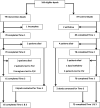The Trial of Ascertaining Individual Preferences for Loved Ones' Role in End-of-Life Decisions (TAILORED) Study: A Randomized Controlled Trial to Improve Surrogate Decision Making
- PMID: 28712987
- PMCID: PMC5632104
- DOI: 10.1016/j.jpainsymman.2017.07.004
The Trial of Ascertaining Individual Preferences for Loved Ones' Role in End-of-Life Decisions (TAILORED) Study: A Randomized Controlled Trial to Improve Surrogate Decision Making
Abstract
Context: Patients with terminal illnesses often require surrogate decision makers. Prior research has demonstrated high surrogate stress, and that despite standards promoting substituted judgment, most patients do not want their surrogates to make pure substituted judgments for them. It is not known how best to help loved ones fulfill the surrogate role.
Objectives: To test the effectiveness of an intervention to help surrogate decision makers.
Methods: One hundred sixty-six patients (41% with amyotrophic lateral sclerosis and 59% with gastrointestinal cancers) and their surrogates at two university medical centers were randomized to an intensive nurse-directed discussion of the end-of-life decision control preferences of the patient (TAILORED) or a discussion of nutrition (CONTROL); 163 completed baseline interviews and underwent the intervention.
Results: Twelve patients died during follow-up and 137 dyads completed the study. Post-intervention, using all available data, TAILORED patients and surrogates became more likely to endorse mutual surrogate decision making, that is, a balance of their own wishes and what the surrogate thinks best (adjusted odds compared with baseline for patients = 1.78, P = 0.04; adjusted odds for surrogates = 2.05, P = 0.03). CONTROL patients became 40% less likely to endorse mutual surrogate decision making (P = 0.08), and CONTROL surrogates did not change significantly from baseline (adjusted odds = 1.44, P = 0.28). Stress levels decreased for TAILORED surrogates (impact of events scale = 23.1 ± 14.6 baseline, 20.8 ± 15.3 f/u, P = 0.046), but not for CONTROL (P = 0.85), and post-intervention stress was lower for TAILORED than CONTROL (P = 0.04). Surrogates' confidence was uniformly high at baseline and did not change. Caregiver burden (Zarit) increased from 12.5 ± 6.5 to 14.7 ± 8.1 for TAILORED (P < 0.01), while not changing for CONTROL, yet satisfaction with involvement in decision making was higher at follow-up for TAILORED than for CONTROL (71% vs. 52%, P = 0.03).
Conclusion: TAILORED patients and surrogates who completed the study adopted a more mutual decision-making style, balancing their own wishes with what the surrogate thinks would be best for them. Surrogates reported less stress and more satisfaction. Confidence was high at baseline and did not change. There was a modest increase in caregiver burden. These findings suggest that interventions like TAILORED might positively impact surrogate decision making.
Trial registration: ClinicalTrials.gov NCT01160367.
Keywords: Ethics; decision-making; end-of-life care; surrogates.
Copyright © 2017 American Academy of Hospice and Palliative Medicine. Published by Elsevier Inc. All rights reserved.
Figures



References
-
- Faber-Langendoen K. A multi-institutional study of care given to patients dying in hospitals. Ethical and practice implications. Arch Intern Med. 1996;156:2130–6. - PubMed
-
- Wendler D, Rid A. Systematic review: the effect on surrogates of making treatment decisions for others. Ann Intern Med. 2011;154:336–46. - PubMed
Publication types
MeSH terms
Associated data
Grants and funding
LinkOut - more resources
Full Text Sources
Other Literature Sources
Medical

